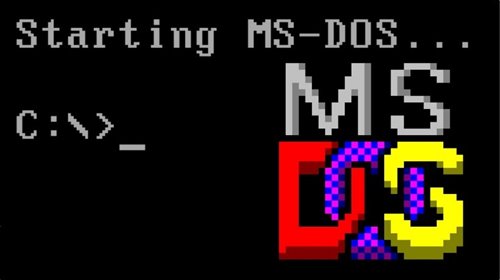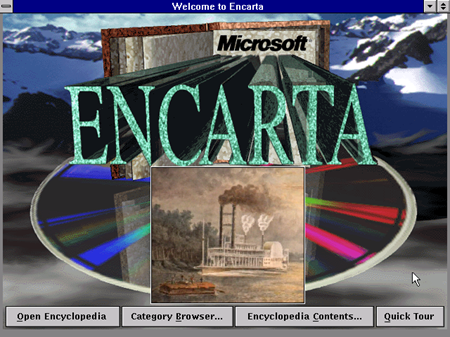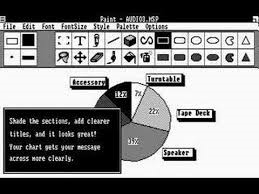By Leanne G.
[
A full list of MS@45 content, resources and the schedule for our online experiences on the weekend of April 4-5 can be found here. Join in the celebration with us! #MSFT45]
Microsoft has now been around for 45 years and has developed software and hardware that has touched every sector of the world of computers and technology. Here’s our roundup of the 15 most impactful products and services developed by this historic firm.
Microsoft BASIC
BASIC was where it all began for Microsoft. The programming language itself was developed at Dartmouth College in 1964 as a way to enable students in fields other than science and mathematics to use computers. At the time, nearly all usage of computers required writing custom software, something only scientists and mathematicians tended to learn. Getting an early jumpstart on the personal computer era, Paul Allen and Bill Gates worked with MITS to write a BASIC interpreter that would run on the groundbreaking Altair 8800.
MS-DOS

In 1981, IBM hired Microsoft to supply an operating system for the IBM PC. What would eventually become MS-DOS was based off a clone of the popular CP/M operating system they purchased from a local company, Seattle Computer Products. The success of MS-DOS was due to the ubiquity of the IBM PC with which it was bundled. Microsoft was now the only company that offered an operating system, programming language interpreters, and application software for the rapidly expanding microcomputer market.
Microsoft Word (and later, Office)
For the new microcomputers flooding into the workplace in the early 80s, Microsoft developed a word processing program. Working with Charles Simonyi and Richard Brodie, primary developers of Bravo, Xerox’s pioneering graphical word processor, this software, unlike most other MS-DOS programs, was designed to be used with a mouse. Although Microsoft Word was not very popular initially, its features and functionality were gradually improved. In 1989, Microsoft debuted a full suite of office software containing many of the programs still in use today. It included a word processor, spreadsheet software, mail program, business presentation software, and more.
Windows
The popularity of graphical user interfaces (GUIs) in the 1980s helped pave the way for Microsoft’s entry into the field. The first version of Windows came out in 1985 and was offered as a graphical extension for MS-DOS. Windows in its many iterations has become one of the most widely used software products in the world. In 2020 there are about
one-and-a-half billion Windows users!
Encarta
Microsoft Encarta was the original digital encyclopedia and one of the first significant programs released on Compact Disc. It included over 50,000 articles, numerous photos and illustrations, music clips, videos, interactive content, timelines, maps, atlases, homework tools, and was published in eight different languages! Unfortunately, Encarta was discontinued in 2009 due to competition from free user-generated websites like Wikipedia.

Microsoft had a shaky start with the World Wide Web, being somewhat blindsided by its popularity and significance in the mid-90s. However, seeing which way the technological winds were blowing, they soon reoriented much of their product development towards this burgeoning platform.
Internet Explorer
Originally Microsoft had not planned to include a web browser with their new Windows 95 operating system. They scrambled to license a program dubbed Internet Explorer from Spyglass, Inc. in August 1995 in order to compete with Netscape Navigator. Thus began the era of the “Browser Wars” as companies jostled for market share in the new world of web browsers. Although the popularity of Internet Explorer has declined, the fact that it was bundled with the Windows 95 Plus! operating system, as well as the Chinese government choosing Windows as their primary operating system, made the usage of Internet Explorer widespread in the late 90s and early 2000s.
MSN
Continuing their expansion into Internet technologies, Microsoft developed MSN (Microsoft Network), an online service to compete with the popular America Online. It functioned as an umbrella service that included all of Microsoft’s online services (news, weather, lifestyle, sports, entertainment, etc.) and an instant messaging system. It also functioned as a major dial-up Internet subscription service. Interestingly enough, MSN is still active today but few still connect via dial-up!
Xbox
Microsoft took the plunge into console gaming in 2001 and created their own home gaming console to compete with Sony and Nintendo. The Xbox was the first American produced console since the Atari Jaguar in 1993. Xbox had a record-breaking launch aided by popular titles such as
Halo. The original console was discontinued in 2005 and succeeded by the Xbox 360. This console outsold competitors like Sony and helped to standardize the idea of a unified online service. The most recent version is the Xbox One, a gaming and multimedia system that can respond to the user’s voice, gestures, or movements.
Xbox Live
Introduced in November 2002, Xbox Live serves as an online multiplayer gaming and digital media service. It created and unified a platform for online gaming services.
MS Paint
The proliferation of graphical user interfaces allowed people to use computers in a whole new way and digital painting programs were an early demonstration of the GUI’s new possibilities. First introduced in Windows 1.0 as a licensed version of ZSoft Corporation’s
PC Paintbrush, what would eventually become Microsoft Paint had limited capabilities and supported only 1-bit monochrome graphics. Included with every version of Windows since, Paint has become the world’s most widely used free art software. In 2017, Microsoft announced they would be discontinuing the software. However, this decision received so much flack from MS Paint fans all over the world that the program is still available today in Windows 10 and in the Microsoft App Store.

Minecraft
Minecraft is a sandbox video game that allows players to build their own virtual worlds using blocks. More than 22 million people own the game, and more than 7,000 classrooms in 40 countries utilize it as an educational resource. First developed by Mojang and released in 2009, Microsoft acquired it in 2014. Minecraft is still an active game today with people building and developing their own worlds on many platforms!
Microsoft Surface
First introduced in 2012 by then-CEO Steve Ballmer, the Surface was Microsoft’s attempt to create touchscreen-based personal computers. This hardware project marked an interesting shift for Microsoft as they had previously been accustomed to licensing out their software to third-party hardware manufacturers.
MS Education
While Microsoft has always developed technology and software that could be utilized in education, this became a large active focus in 2017. As the landscape of technology was changing once again, Microsoft set out to impact the ways technology was used in the classroom, creating resources for educators, providing personal computers to students, and creating a curriculum for coding.
Azure
Microsoft Azure is a cloud-based computing platform that offers over 600 services. First developed in 2008, Azure focuses on building, testing, deploying, and managing applications and services through Microsoft-managed data centers. These cloud-based services can be utilized in a variety of ways and across many fields and industries. Azure also supports messaging platforms like Microsoft Teams which saw a 775% (!) increase in usage in March of 2020.
HoloLens
HoloLens is a product that incorporates “mixed reality” smart-glasses that merge real and virtual worlds to produce new environments and visualizations. First developed in 2016, this is still a relatively new field for Microsoft and the computer industry as a whole but promises exciting developments in the future to come.